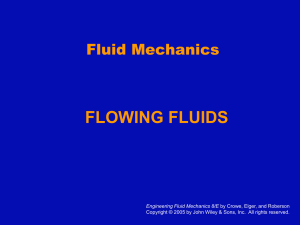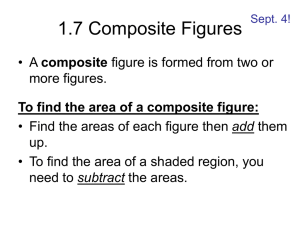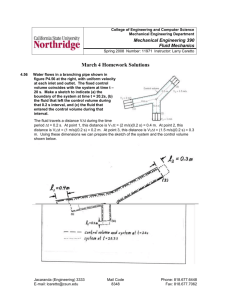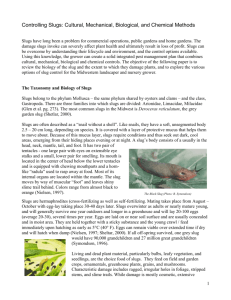February 19
advertisement
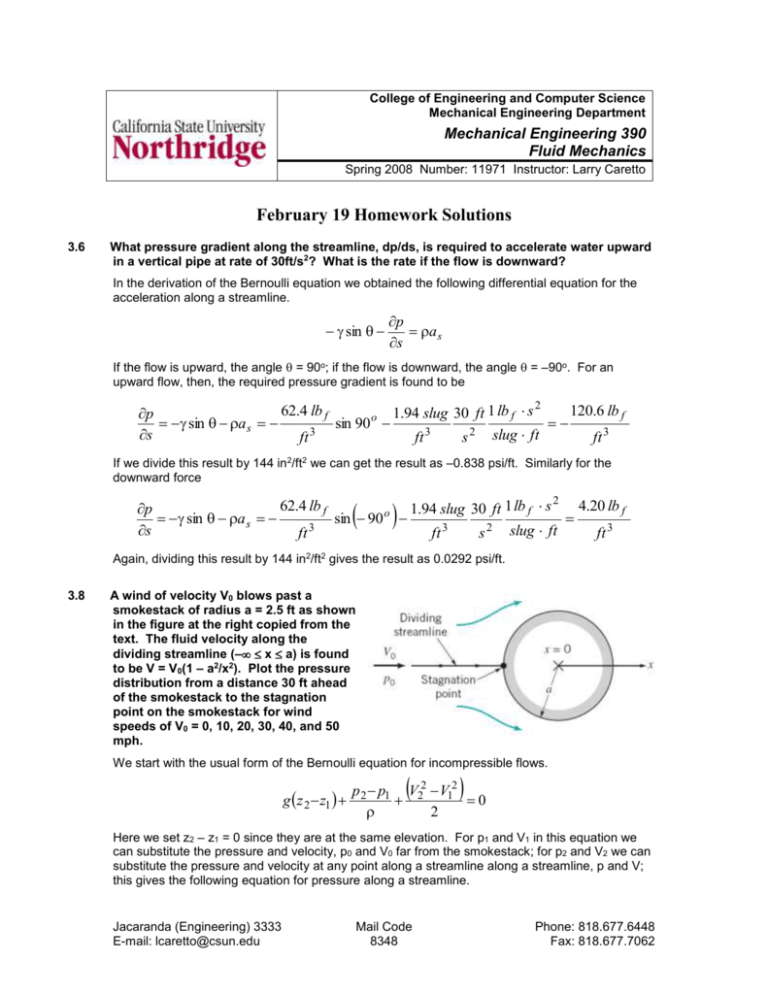
College of Engineering and Computer Science Mechanical Engineering Department Mechanical Engineering 390 Fluid Mechanics Spring 2008 Number: 11971 Instructor: Larry Caretto February 19 Homework Solutions 3.6 What pressure gradient along the streamline, dp/ds, is required to accelerate water upward in a vertical pipe at rate of 30ft/s2? What is the rate if the flow is downward? In the derivation of the Bernoulli equation we obtained the following differential equation for the acceleration along a streamline. sin p a s s If the flow is upward, the angle = 90o; if the flow is downward, the angle = –90o. For an upward flow, then, the required pressure gradient is found to be 2 62.4 lb f 120.6 lb f p o 1.94 slug 30 ft 1 lb f s sin a s sin 90 s ft 3 ft 3 s 2 slug ft ft 3 If we divide this result by 144 in2/ft2 we can get the result as –0.838 psi/ft. Similarly for the downward force 2 62.4 lb f 4.20 lb f 1.94 slug 30 ft 1 lb f s p o sin a s sin 90 s ft 3 ft 3 s 2 slug ft ft 3 Again, dividing this result by 144 in2/ft2 gives the result as 0.0292 psi/ft. 3.8 A wind of velocity V0 blows past a smokestack of radius a = 2.5 ft as shown in the figure at the right copied from the text. The fluid velocity along the dividing streamline (– x a) is found to be V = V0(1 – a2/x2). Plot the pressure distribution from a distance 30 ft ahead of the smokestack to the stagnation point on the smokestack for wind speeds of V0 = 0, 10, 20, 30, 40, and 50 mph. We start with the usual form of the Bernoulli equation for incompressible flows. g z 2 z1 p 2 p1 V22 V12 0 2 Here we set z2 – z1 = 0 since they are at the same elevation. For p1 and V1 in this equation we can substitute the pressure and velocity, p0 and V0 far from the smokestack; for p2 and V2 we can substitute the pressure and velocity at any point along a streamline along a streamline, p and V; this gives the following equation for pressure along a streamline. Jacaranda (Engineering) 3333 E-mail: lcaretto@csun.edu Mail Code 8348 Phone: 818.677.6448 Fax: 818.677.7062 February 19 homework solutions ME 390, L. S. Caretto, Spring 2008 Page 2 2 2 p po V V0 p 2 p1 V22 V12 g z 2 z1 g 0 0 2 2 Rearranging this equation and substituting the equation given in the problem statement, V = V0(1 – a2/x2), gives the following equation for p. 2 V 2 V02 V02 a 2 V02 V02 a 2 a 4 V02 p po po 1 po 1 2 2 4 2 2 2 x 2 2 2 2 x x Simplifying this equation and plugging in data (p0 = 0, a = 2.5 ft and = 0.002328 slugs/ft2 for air) gives. V 2 p po 0 2 a 2 a 4 0.002328 slugs 1 lb f s 2 V02 2.5 ft 2 2.5 ft 4 2 2 3 2 4 x2 x4 slug ft 2 ft x x We see that if V0 is in ft/s the resulting units for p will be lbf/ft2. Values of x must be in ft for dimensional consistency. Doing the calculations in a spreadsheet for various distances along the streamline from x = -30 ft to x = a = 2.5 ft gives the following results. V0 (mph) V0 (ft/s) 10 20 30 40 50 14.6667 29.3333 44 58.6667 73.3333 Streamline pressures for V0 values above and x locations at left x = -30.0 ft x = -29.5 ft x = -29.0 ft x = -28.5 ft x = -28.0 ft x = -27.5 ft x = -27.0 ft x = -26.5 ft x = -26.0 ft x = -25.5 ft x = -25.0 ft x = -24.5 ft x = -24.0 ft x = -23.5 ft x = -23.0 ft x = -22.5 ft x = -22.0 ft x = -21.5 ft x = -21.0 ft x = -20.5 ft x = -20.0 ft x = -19.5 ft x = -19.0 ft x = -18.5 ft x = -18.0 ft x = -17.5 ft x = -17.0 ft 0.0035 0.0036 0.0037 0.0038 0.0040 0.0041 0.0043 0.0044 0.0046 0.0048 0.0050 0.0052 0.0054 0.0056 0.0059 0.0061 0.0064 0.0067 0.0070 0.0074 0.0078 0.0082 0.0086 0.0091 0.0096 0.0101 0.0107 0.0139 0.0143 0.0148 0.0154 0.0159 0.0165 0.0171 0.0177 0.0184 0.0192 0.0199 0.0207 0.0216 0.0225 0.0235 0.0246 0.0257 0.0269 0.0282 0.0296 0.0311 0.0327 0.0344 0.0362 0.0383 0.0405 0.0429 0.0312 0.0323 0.0334 0.0345 0.0358 0.0371 0.0385 0.0399 0.0415 0.0431 0.0448 0.0467 0.0486 0.0507 0.0529 0.0553 0.0578 0.0605 0.0634 0.0665 0.0699 0.0735 0.0774 0.0816 0.0861 0.0910 0.0964 0.0554 0.0573 0.0593 0.0614 0.0636 0.0659 0.0684 0.0710 0.0737 0.0766 0.0797 0.0830 0.0865 0.0902 0.0941 0.0983 0.1028 0.1076 0.1128 0.1183 0.1242 0.1306 0.1375 0.1450 0.1531 0.1619 0.1714 0.0866 0.0896 0.0927 0.0960 0.0994 0.1030 0.1069 0.1109 0.1152 0.1198 0.1246 0.1297 0.1351 0.1409 0.1470 0.1536 0.1606 0.1681 0.1762 0.1848 0.1941 0.2041 0.2149 0.2265 0.2392 0.2529 0.2678 February 19 homework solutions x = -16.5 ft x = -16.0 ft x = -15.5 ft x = -15.0 ft x = -14.5 ft x = -14.0 ft x = -13.5 ft x = -13.0 ft x = -12.5 ft x = -12.0 ft x = -11.5 ft x = -11.0 ft x = -10.5 ft x = -10.0 ft x = -9.5 ft x = -9.0 ft x = -8.5 ft x = -8.0 ft x = -7.5 ft x = -7.0 ft x = -6.5 ft x = -6.0 ft x = -5.5 ft x = -5.0 ft x = -4.5 ft x = -4.0 ft x = -3.5 ft x = -3.0 ft x = -2.5 ft 0.0114 0.0121 0.0129 0.0137 0.0147 0.0157 0.0169 0.0182 0.0196 0.0213 0.0231 0.0252 0.0276 0.0303 0.0335 0.0371 0.0414 0.0465 0.0526 0.0598 0.0686 0.0794 0.0928 0.1095 0.1307 0.1574 0.1903 0.2270 0.2504 ME 390, L. S. Caretto, Spring 2008 0.0455 0.0483 0.0514 0.0549 0.0587 0.0629 0.0675 0.0727 0.0785 0.0851 0.0924 0.1008 0.1103 0.1213 0.1339 0.1486 0.1658 0.1861 0.2102 0.2392 0.2744 0.3176 0.3711 0.4382 0.5228 0.6296 0.7613 0.9080 1.0016 0.1023 0.1087 0.1157 0.1235 0.1320 0.1414 0.1519 0.1636 0.1767 0.1914 0.2080 0.2268 0.2483 0.2729 0.3013 0.3343 0.3730 0.4186 0.4730 0.5382 0.6174 0.7145 0.8350 0.9859 1.1764 1.4167 1.7129 2.0431 2.2535 0.1818 0.1932 0.2057 0.2195 0.2346 0.2514 0.2701 0.2908 0.3141 0.3402 0.3697 0.4032 0.4413 0.4851 0.5357 0.5944 0.6631 0.7443 0.8408 0.9568 1.0976 1.2703 1.4844 1.7527 2.0913 2.5186 3.0451 3.6322 4.0062 Page 3 0.2841 0.3019 0.3215 0.3429 0.3666 0.3929 0.4220 0.4544 0.4908 0.5316 0.5777 0.6300 0.6896 0.7580 0.8370 0.9287 1.0362 1.1629 1.3138 1.4950 1.7150 1.9848 2.3194 2.7386 3.2677 3.9353 4.7580 5.6753 6.2597 Plotting these results gives the graph on the next page. 3.10 Water flows around the vertical twodimensional bend with circular streamlines and constant velocity as shown in the figure at the right (Figure P3.10 in the text Fluid Mechanics by Munson et al.) If the pressure is 40 kPa at point(1), determine the pressures at points (2) and (3). Assume that the velocity profile is uniform as indicated. Here we are asked to find pressures normal to a streamline. The basic equation for such pressures is dz p V 2 0 dn n The n coordinate points towards the center of the radius of curvature. If we start the n coordinate at the bottom center of the cylinder then n will increase as z increases such that dz/dn = 1. At the lower wall of the bend, when n = 0, the radius of curvature, = 6 m. At any other points along the flow path, = 6 – n. Setting dz/dn = 1 and = 6 – n gives the following equation. February 19 homework solutions ME 390, L. S. Caretto, Spring 2008 Page 4 dp dz V 2 V 2 dn dn 6n Streamline Pressures from Problem 3.8 7 6 V0 = 50 mph V0 = 40 mph V0 = 30 mph 5 V0 = 20 mph V0 = 10 mph 4 p(x) lb/ft2 3 2 1 0 -30 -25 -20 -15 -10 -5 0 x (ft from center) Multiplying the previous equation by dn and integrating from n = 0 to an arbitrary value of n gives. p p1 n 0 V 2 n 0 dn' 6n n V 2 ln 6 n'0n n V 2 ln 6 n' 6 We can apply this equation to get the pressure at point (2) where the value of the n coordinate is 1 m. Using the values of = 9.81 kN/m3 and r = 999 kg/m3 for water from Table 1-6 on the inside front cover, along with the problem data that p1 = 40 kPa and V = 10 m/s gives the desired p2. 6 n2 p 2 p1 n2 V 2 ln 40 kPa 6 2 9.8 kN 999 kg 10 m 6 m 1 m kN s 2 kPa m 2 (1 m) ln 3 m 3 s 6 m 1000 kg m kN m February 19 homework solutions ME 390, L. S. Caretto, Spring 2008 Page 5 P2 = 12.0 kPa At point 3, the value of the normal coordinate, n, is 2 m. Making the same calculation with n = 2 gives. 6 n3 p3 p1 n3 V 2 ln 40 kPa 6 2 9.8 kN 999 kg 10 m 6 m 2 m kN s 2 kPa m 2 ( 2 m) ln 3 m 3 s 6 m 1000 kg m kN m P2 = –20.1 kPa This problem shows that the pressure decreases as we move towards the center of a circulating flow. 3.13 As shown in the figure on the right (Figure P3.13 in the text Fluid Mechanics by Munson et al.) and video 3.2, the swirling motion of a liquid can cause a depression in the free surface. Assume that an inviscid liquid in a tank with an R = 1.0 foot radius is rotated sufficiently to produce a free surface that is h = 2.0 ft below the liquid at the edge of the tank at position r0 = 0.5 ft from the center of the tank. Also assume that the liquid velocity is given by V = K/r, where K is a constant. (a) Show that h = K2[(1/r02) – (1/R2)]/(2g). (b) Determine the value of K for this problem. In this swirling flow, the velocity components in the radial and vertical directions are zero. All the flow is rotational. Thus the streamlines (tangents to the velocity vector) are circles and the normal direction to these circular streamlines is the same as the r direction. However, we noted that the normal direction points to the center of the curved streamlines, so we must have n = –r for this flow. As in the previous problem, we start with the equation for forces normal to a streamline. dz dp V 2 0 dn dn Since n = –r, it is independent of the other coordinates so the derivative dz/dn = 0. Also, in this equation, dn = –dr, and the radius of curvature, = r. With these substitutions, and the equation given in the problem statement that V = K/r, our balance equation becomes dp V 2 0 dr r dp V 2 K 2 3 dr r r Multiplying by dr and integrating between the free surface (p0,r0) and an arbitrary point in the flow, (p,r) gives the pressure distribution. K 2 K 2 p dp p p0 r r 3 dr 2r 2 p r 0 0 r r0 K 2 1 1 2 r 2 r02 At the free surface, the gage pressure p0 = 0. At the wall where r = R, the pressure is given by the hydrostatic pressure since there are no curved streamlines between the top of the liquid at the wall and the wall liquid at a depth h. Thus, at the outer radius R and a depth h below the top of February 19 homework solutions ME 390, L. S. Caretto, Spring 2008 Page 6 the liquid at r = R, the pressure p = h = gh. Setting p – p0 = rgh and r = R gives the desired equation for height. p p0 gh K 2 1 1 2 2 2 r0 R h K2 2g 1 1 2 2 r0 R Applying this equation to the given data that r0 = 0.5 ft when h = 2 ft gives the following value for K. 2 gh 1 1 r02 R 2 K 3.14 32.174 ft 2 ft s2 1 1 2 0.5 ft 1 ft 2 2 K = 6.55 ft2/s Water flows from the faucet on the first floor of the building shown in the figure (Figure P3.14 in the text Fluid Mechanics by Munson et al.) with a maximum velocity of 20 ft/s. For steady inviscid flow, determine the maximum water velocity from the basement faucet and from the faucet on the second floor. Assume that each floor is 12 ft tall. We start with the Bernoulli equation for steady, inviscid, incompressible flow along a streamline. p 2 p1 V22 V12 g z 2 z1 0 2 The flow at both the first floor (point 1)and the basement (point 2) is open to the atmosphere so we have p1 = p2 = 0. The elevation difference z2 – z1 = –12 ft. We are given that V1 = 20 ft/s so we can solve for V2 as follows. 2 32.174 ft 20 ft 12 ft V2 V 2 g z 2 z1 2 s2 s 2 1 V2 = 34.2 ft/s As expected, the flow at the lower elevation is greater. If we now apply the same analysis between the ground floor (point 1) and the second floor (point 3) we have the same data except that now z3 – z1 = +12 ft. 2 32.174 ft 20 ft 12 ft 373 ft V3 V 2 g z 3 z1 2 2 s s s 2 1 V3 = must be zero; flow cannot reach second floor 2 February 19 homework solutions 3.18 ME 390, L. S. Caretto, Spring 2008 Page 7 A fire hose nozzle has a diameter of 1.125 in. According to some fire codes, the nozzle must be capable of delivering at least 250 gal/min. If the nozzle is attached to a 3in diameter hose, what pressure must be maintained just upstream of the nozzle to deliver this flowrate? (Problem 3.18 from Munson et al., Fluid Mechanics text; figure from solutions manual.) We start with the usual from of the Bernoulli equation for incompressible flows. p p V g z 2 z1 2 1 2 2 V12 0 2 At the open outlet the gage pressure is zero. The outlet is at the same elevation as the point (1) so z2 – z1 = 0. Since the fluid is incompressible the continuity equation for this problem becomes V1A1 = Q1 = Q2 = V2A2, where A1 = D12/4 = (3 in)2(1 ft2/144 in2)/4 = 0.049087 ft2and A2 = D22/4 = (1.125 in)2(1 ft2/144 in2)/4 = 0.006903 ft2. We thus find that V2 = Q2/A2 = (250 gal/min) (1 ft3/7.4805 gal) / (0.006903 ft2) = 4,841 ft/min = 80.69 ft/s. From the continuity equation we have V1 = Q1/A1 = Q2/A1 = (250 gal/min)(1 ft3/7.4805 gal) / (0.006903 ft2) = 680.83 ft/min = 11.347 ft/s. We can apply the above results to Bernoulli’s equation with a water density of 1.94 slugs/ft3 from Table 1.5 on the inside front cover. g z 2 z1 p 2 p1 V 2 2 2 2 V12 0 p1 1 80.69 ft 11.347 ft g 0 1.94 slugs 2 2 s s 3 ft Solving this equation for p1 gives. 2 2 2 lb f 1.94 slugs 1 80.69 ft 11.347 ft 1 lb f s ft 2 p1 43 . 0 2 2 s s ft 3 in 2 slug ft 144 in

